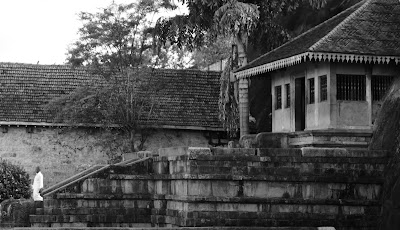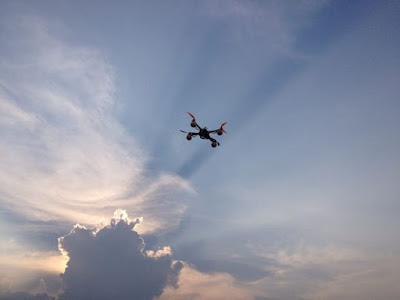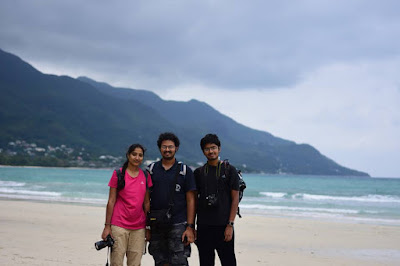 |
| Isurumuniye, Anuradhapura |
Sri Lanka had always been at the top of the bucket list for a long time, particularly because of its proximity to Southern India and for its Buddhist past. SpiceJet gave an offer that we could not reject in February of this year and we immediately grabbed it. We planned to spend an extended weekend in Sri Lanka and so had four days to spend. This trip was going to be a backpacker style thing and we had to experience a slice of everything. The bustling metropolis of Colombo. The aftermath of the Sri Lankan Civil War and the Tamil north. A bit of the Buddhist past and a bit of the splendid wildlife. So, accordingly we rationed one day to visiting Colombo, another day around Jaffna and Point Pedro and one day each at Anuradhapura's sacred city and Wilpattu National Park. We pre-booked a bus from Colombo to Jaffna through busseat.lk. Pretty much everything else had to be figured out as we went along. We transited Chennai on the way there as we got a really good deal from Chennai to Colombo. After spending a day meeting Jithin in IITM and a couple of relatives around the city, we were on our way. The customs official in Chennai Intl. Airport warned us to declare our cameras and other expensive electronics to avoid being interrogated upon our return. We packed two DSLRs and five lenses, including the massive Tamron 150-600 and so had to declare them. We departed Chennai approximately at midnight on 5th May.
 |
| Pettah floating market. |
 |
| Galle Face Green |
 |
| Independence Memorial |
 |
| Gangaramaya Temple, Colombo |
We landed in Colombo at 1:30 AM on 6 May and reached Colombo Monkey Hostel in the heart of the city promptly. This is probably the best backpacker hostel we ever visited. The next morning we went out by foot to explore. After some roaming around, we hired a tuk-tuk for 500 LKR per hour to show us around. The first stop was Gangaramaya Temple. This place is synonymous with the city on tourism posters. It indeed is beautiful and extremely photogenic. We visited the Independence memorial and the Viharamahadevi Park. It started to rain and we asked to be dropped off at a restaurant near Pettah. After having a sumptuous lunch, we headed off to the hostel to pick up our bags and check-out. After lazing around for an hour, we walked a bit and took a tuk-tuk to the floating market of Pettah. The main floating market was closed but there were plenty of window shopping to be done around it. We took a bus from there, bound to Galle Face Green. We watched the sunset at Galle Face and finished our dinner in one of the upscale restaurants around it. Galle Face is a very happening place where everyone flocks to. All sorts of characters appear after dark. Snake charmers, monkey charmers, roadside vendors and the like. We caught our bus to Jaffna from Galle Face later that night. Though not nearly as comfortable as Indian Volvo buses (while being similarly priced), this A/C bus served the purpose.
 |
| Srivani at the Dutch Fort. |
 |
| Near Point Pedro |
 |
| Jaffna Railway Station |
 |
| Cape Sakkotai |
Jaffna was at the top of my bucket list for quite some time, mainly because of its past and prominence in the civil war. Though the largest Tamil city was always Trincomalee, Jaffna was referred to as the Tamil cultural capital. It was here that the IPKF first landed during the Indian intervention of the late 1980s. I grew up reading about the Jaffna University airdrop. It was in this trip that I finally got to visit the place in person. It was the height of the summer season and Jaffna was sweltering hot, even at 7AM when the bus dropped us off in Point Pedro. A short 3 Km walk through the coastal roads brought us to Cape Sakkotai. This was the northern most point in all of Sri Lanka. Less than a decade ago, this was a Sea Tiger hub and totally inaccessible to any foreign traveler. We caught a local bus that brought us to Jaffna town from Point Pedro. In Jaffna, while Srivani was getting ready, I went to figure out a way to leave Jaffna that day. The best way seemed to be by rail and thankfully, the railway station was about 1 Km from the hotel. On the way I observed that heavily armed soldiers of the Sri Lankan Army were guarding the streets. There was even a sniper hiding in a building riddled with bullet holes. Only the "first class" in one train had vacancies for that day and I got the tickets. The "first class" was almost like the A/C chair car in an Indian train. There were a few prominent places to visit before we caught the train out of Jaffna. One of them was the old Dutch fort overlooking the sea. This site is well known in history for being a point of contention between the Dutch and the British during the Colonial Age. Other points of interest included the Jaffna Public Library and the Jaffna University. Jaffna had a very different air about it. There were vegetarian Tamil restaurants around and many Hindu temples. A stark contrast from the predominantly Buddhist Colombo. This was during the time when Baahubali 2 was released. The Tamil version was being screened in several theatres. We finally caught the train out of Jaffna at around 2 PM. The scenery was beautiful. The train crossed the Elephant Pass and then onto the mainland, ending in Anuradhapura.
 |
| Jethawanaramaya |
 |
| Ruwanwelisaya |
 |
| At Ruwanwelisaya |
 |
| The first temple of the tooth |
 |
| Isurumuniye lovers sculpture |
 |
| Samadhi Buddha |
Anuradhapura was the ancient Buddhist capital of Sri Lanka and probably of the Theravada Buddhist world. It was here that the children of Emperor Asoka, Sanghamitra and Mahindra landed, a couple of centuries after the death of the Buddha. Sanghamitra arrived with a cutting of the Mahabodhi tree and planted it here. This stands even today and remains the oldest human-planted tree in the world. Mahindra arrived carrying the collar bone of the Buddha and persuaded the ruling king to build a stupa to house it. This was the first stupa on the island and is called Thuparamaya. We were hosted by the wonderful family of Mrs. Hema Latha and her daughter, Poornima at their homestay, Senowin. We ended up discussing throughout the length and breadth of religion and politics and the war. They arranged bicycles for us for the next day. We calculated that it's better to bike around the ancient city than to hurry it out in a tuk-tuk. The next morning we cycled the 4 km to the first monument. This was the Jaya Maha Bodhi, the cutting planted by Sanghamitra more than two millennia ago. We cycled around to the main stupas. The entry fee is pretty steep here for foreigners, though we got a 50% discount as SAARC members. We first headed to the beautiful Ruwanwelisaya. It's a gigantic white stupa, visible even from the new city. We passed this and headed to Thuparamaya, the stupa which houses the Buddha's bones. We had a good close look at the collar bone of the Buddha, brought by Mahindra, here. We then cycled north to Abhayagiri monastery and its accompanying stupa. This day was just two days before the Buddhist new year and was hence heavily decorated and full of activity. We went ahead to visit the moonstone and the Samadhi Buddha statue. The moonstone is something unique to Sri Lanka. It's a set of concentric circular carvings depicting a Buddhist's journey from the material world to nirvana, depicted by material things on the outer edges, slowly transforming into swans and then finally into the lotus in the middle, which stands for nirvana. The Samadhi Buddha statue is an exquisite sculpture dating back to about the 2nd century AD, showing Buddha in the Samadhi posture. We then cycled back to the Twin Ponds and then south to Jethawanaramaya and Lovamahapaya. Jethawanaramaya stands tall at over 140 metres (even with the spire broken). It's about twice as tall as the Qutub Minar or the Taj Mahal, built centuries and millennia later. It counts amongst the tallest buildings in the ancient world, in the same league as the pyramids of Egypt. On the road from Thuparamaya as also the ruins of the first temple of the tooth. It once housed the tooth of the Buddha before being transferred to a much bigger shrine in Kandy. We then proceeded west, along the lake Basawkkulama. Our last stop was the temple of Isurumuniye. This place is famous for the Isurumuniye lovers sculpture, amongst other things. It shows a prince making love to a dancing girl. We then returned back to Senowin to rest for the night.
 |
| The lesser egret. |
 |
| Peacock |
 |
| Mugger crocodile |
 |
| Wilpattu National Park |
The next morning, we had a taxi pick us up at Senowin to take us to Wilpattu National Park. Wilpattu is probably the park with the least number of tourists and hence the most pristine. However, this also means that the animals are not usually accustomed to human contact, thus making sightings rare. Wilpattu was not renowned for anything in the manner of Sinharaja(for tropical birds) or Yala (for leopards). It was, however, the largest park that Sri Lanka had and the most untouched. This also explains why we needed a cab to get there. We did a half-day safari here. There's plenty of wildlife to be spotted and photographed. However, the average tourist who looks for big cats will end up disappointed (there are no tigers in Sri Lanka and leopards are notoriously elusive). There seemed to be no restriction on how much of the park should be open to safaris (it's about 20% in India) and the safari crossed almost the entire breadth of the park. We finished the visit by noon and were on our way to the airport by the same cab. It was a short drive to Colombo and we were in Katunayake by noon, having lunch by the beach overlooking the Negombo lagoon. We lazed around for a while and crawled into the airport which was a few minutes walk away, thus ending the trip.
 |
| Anuradhapura |
This was a quick trip and was packed to the brim. India and Sri Lanka share a lot of culture and history, but are in quite different in their ways. In the wildlife aspect, Sri Lanka is somewhat like a miniature Madagascar. The lack of tigers seems to have made leopards the top predators here. Sri Lanka has many species endemic to it due to the separation by sea. The bike ride around Anuradhapura was by far the best thing about this trip. The people were always cordial and polite, be it in the cities or the villages and helped us along the way. I look forward to coming back here!






















Comments
Post a Comment